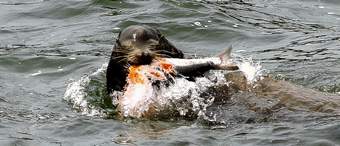forum
library
tutorial
contact

Columbia River Chinook Run
to Date Lowest Since 1949
by Associated Press
Seattle Post-Intelligencer - April 5, 2005
|
the film forum library tutorial contact |

|
Columbia River Chinook Runby Associated Press
|
 NORTH BONNEVILLE, Wash. -- The spring chinook salmon count at Bonneville Dam so far is the lowest since 1949 for reasons that include probably drought and sea lions, scientists say.
NORTH BONNEVILLE, Wash. -- The spring chinook salmon count at Bonneville Dam so far is the lowest since 1949 for reasons that include probably drought and sea lions, scientists say.
The prized fish also may be waiting longer before going upriver to spawn, said Robin Ehlke, a biologist in the state Department of Fish and Wildlife.
"There's likely more than one thing going on here," Ehlke told The Columbian of Vancouver. "The run may be late, we've got marine mammals in the fish ladder and there were drought-like conditions in March with stream flows 65 percent of normal."
The Columbia River Compact was scheduled to meet on Monday to consider additional commercial fishing seasons but decided not to bother. Recreational fishing seasons remain unchanged.
In December, Oregon and Washington state and tribal biologists predicted 254,100 spring chinook would head up the Columbia River for tributaries upstream of Bonneville Dam.
Through Sunday, typically the point at which 5 percent of the run has passed the dam, the count was 48 fish, compared with a 10-year average of 6,855 through April 3.
On Sunday state observers counted 14 California sea lions between the Hamilton Island boat ramp downstream from the dam and the entrance to the fish ladder, plus one sea lion in the fish ladder.
Joe Hymer, a Washington state fish biologist, said the last time the count at Bonneville was so low was in 1949, when the combined spring count of adult and immature or "jack" salmon was about 50,000.
In the last low year, 1995, the count by April 3 was 400 adult spring chinook and the final tally for the run was 10,200, Hymer said.
Commercial test fishing with small mesh nets on Sunday nights also has produced disappointing results and signs of high predation by marine mammals, Ehlke said.
"For the first week of April, we'd expect to see more than two to three chinook per drift," she said. "The good news is there was a greater percentage of upper Columbia fish, and that's a positive indicator" that the run may pick up later.
Half of the spring chinook usually have passed the dam by April 26, so scientists say it will likely be at least two weeks or more before they have a better sense of the strength of the run.
Related Pages:
Big Spring Chinook Runs Due in Columbia by Allen Thomas, The Columbian, 12/23/4
| Year of Return | Columbia River | Willamette River |
|---|---|---|
| 1992 | 95,323 | 65,200 |
| 1993 | 119,203 | 60,800 |
| 1994 | 23,809 | 46,400 |
| 1995 | 12,634 | 40,800 |
| 1996 | 55,299 | 33,200 |
| 1997 | 123,824 | 34,300 |
| 1998 | 43,512 | 43,500 |
| 1999 | 42,582 | 52,600 |
| 2000 | 186,141 | 55,800 |
| 2001 | 437,910 | 80,300 |
| 2002 | 331,303 | 121,700 |
| 2003 | 242,638 | 117,600 |
| 2004 | 221,600 | 143,700 |
| 2005* | 254,100 | 116,900 |
learn more on topics covered in the film
see the video
read the script
learn the songs
discussion forum
